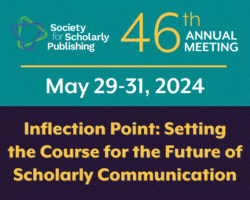New Member Profile
 SSP membership offers a variety of opportunities for professionals across the field of scholarly publishing. In our profiles featuring individuals who have recently joined, learn about the experiences of new members as they spotlight ways to get involved, connect with colleagues, and share knowledge in the industry. Latoya Fladger is the Client Development Manager at Cactus Communications. She joined SSP after attending the Annual Meeting this year in Chicago, and currently serves on the Annual Meeting Program Committee.
SSP membership offers a variety of opportunities for professionals across the field of scholarly publishing. In our profiles featuring individuals who have recently joined, learn about the experiences of new members as they spotlight ways to get involved, connect with colleagues, and share knowledge in the industry. Latoya Fladger is the Client Development Manager at Cactus Communications. She joined SSP after attending the Annual Meeting this year in Chicago, and currently serves on the Annual Meeting Program Committee.
Tell us a little about yourself and your early professional background.
After graduating undergrad, I was seeking a career in the communications field because my Bachelor of Science degree was focused on that, with a concentration in PR. I was struggling to get into that realm in Raleigh and just happened to see a Craigslist ad for an editorial assistant. This was back in 2013, and it sounded like a great full-time job to do until I found the perfect position in PR. Six years later, I was still at J&J Editorial! So I feel super blessed and lucky to have found that position off of Craigslist because it opened my world to scholarly publishing. It wasn’t that I had never heard of the field, I just never knew what it entailed. I didn’t understand the amount of work and the process that goes into it. When I started off at J&J as an editorial assistant, I believe I was the 20th contractor that they had. By the time I left I was a senior managing editor and they had reached over 100 employees. I really saw the industry in a positive light and I also saw the amount of work required in order to get this important information out into the world.
What does your work look like now?
I am actually in sales now. I am a client development manager for Cactus, one of three US-based sales people. We are totally remote so now I’m based in Tampa, FL. I do feel some similar culture similarities to those at J&J. Just being able to talk openly, share ideas openly, and see how we can move things forward sooner rather than later, because this is scholarly publishing. Those similarities I do get also from Cactus. It’s a good environment.
How did you transition into a sales role?
I did a brief stint in the marketing space and ghostwriting realm that was taking place in 2019, when I left J&J. I left because I felt like at that time I had reached the ceiling whenever it comes to growing my career there. Now, of course—because I just saw them at SSP’s annual meeting—they have a plethora of positions, but my direct boss and her boss are still there. At the time it was really a question of whether I should take a chance and leave because I was recruited by a startup, or did I want to stay? At that time I was wrapping up my Master’s degree in liberal studies at Duke, and I just decided to take a chance. That was a brief stint because the startup did fail. So then I decided to go into real estate, and real estate was really how I found my footing in the sales realm. Before then, I wasn’t selling anything. It felt scary, but real estate allowed me to see that you don’t have to come off as a sales person, and you can also tailor what you do and make it unique to yourself.
How did you come back to scholarly publishing?
I got burnt out on real estate and I was looking to work for a tech company doing a hybrid of client management and sales. I stumbled upon a LinkedIn job posting which sounded really cool with Cactus and I applied for it, and then everything just fell into place with me accepting the job offer.
How have you found the culture of working in the scholarly publishing world?
That’s one thing I want to stress: that the scholarly publishing community is very welcoming. It’s amazing, just the number of opportunities and the people who are super busy but who will take the thirty minutes to chat with you.
How did you get involved in SSP?
While I was at J&J it was highly encouraged to join an organization. and at that time I jointed ISMTE. I was already attending the local meetings in Durham once a month and I had already been to a few of their annual meetings so it just seemed easy and so this time around, having attended SSP for the second time, I knew that I wanted to get involved again. I do find that, at least for myself, I like to make sure that any free time that I do have is spent on a healthy project that allows me to communicate with others from outside at other organizations.
What was your experience at the Annual Meeting like and why did you decide to join the Annual Meeting Program Committee?
SSP was amazing this year. The keynote speaker really did it for me, because he looked like me and I wasn’t used to that. Just from the good vibes, my old team being there, welcoming me, wishing me luck with my new role—it felt like such a positive environment.
The diversity of sessions also made the meeting stand out. This was the first time I was struggling with which session to go to, whereas in the past there are usually a few good ones and then the rest I’m just not interested. This time I was asking myself, “do I want to go to this one? Or which one would be better?” One session I attended, the improv session, was just—wow. It was super cool and highlighted what we can do in this industry, how we can make it fun. That’s what I enjoy.
Now I’m interested in making sure that other people have that same experience next year, and so thankfully I’m on the Annual Meeting committee. At J&J, I was on the events committee and I like a little bit of planning. So I thought the Annual Meeting committee would also be the best fit for my personality.
What have you found valuable about SSP membership so far?
The communications from C3 are one thing. Just the fact that people can share what they have going on and ask questions about if someone has a resource, I love that. The sense of community is what I’ve already experienced. The access to the webinars has also been awesome, like the Early Career Webinar I attended.
What would you recommend to someone looking to get more involved professionally?
I would share what my boss at J&J encouraged me to do, which was to ease into it. At first she suggested that I read The Scholarly Kitchen. She told me this is a platform where you can keep up on interesting industry news. So I was encouraged to start reading that, and then she told me to explore some of the main organizations, see which one fits your interests, go to these monthly meetings. And so I think that—especially after having the committee orientation—I felt like it felt less overwhelming because I was eased into a position where I was excited about being involved.
So I would suggest first to get familiar. Start with webinars, start with The Scholarly Kitchen, and just get familiar with what you’re most interested in. If maybe joining a committee doesn’t work for you right now, would you be interested in doing a guest post on a specific topic? I think that there’s enough for anyone to find something that may spark their interest.
SSP members represent the many elements involved in the broad field of scholarly publishing — publishers, e-product developers, librarians, publishing service vendors, editors, and more. Learn about the benefits of joining our community!


